Consumers can buy whatever, wherever, and whenever they want. As a result, seamlessomnichannel experiencesare no longer a novelty—they’re the expectation.
Businesses providing these cohesive and integrated shopping experiences are winning over competitors. In fact,70% of consumersspend more with companies that offer fluid, personalized, and seamless customer experiences.
This guide will cover everything you need to know to optimize your omnichannel marketing efforts.
Table of contents:
- What is omnichannel marketing?
- What are the benefits of the omnichannel marketing approach?
- What’s the difference between omnichannel marketing and multichannel marketing?
- How does omnichannel attribution work?
- Omnichannel marketing trends
- How to create an omnichannel campaign
- Omnichannel marketing examples
- How Shopify can help with omnichannel marketing
- Omnichannel marketing FAQ
What is omnichannel marketing?
Omnichannel marketing refers to an integrated approach that uses many channels, such as social media, email, and SMS, to reach a customer. Brands use omnichannel marketing to create a seamless user experience across all touch points.

What an omnichannel experience looks like versus multichannel. | Source:ResearchGate
SAB reportsthat customer touch points have more than doubled over the past five years. Today’s consumers expect seamless and cohesive shopping experiences—no matter where or when they come in contact with your brand.
Omnichannel marketing meets the demands of today’s tech-savvy consumers through highly personalized, consistent, and regularly updated marketing.
What are the benefits of the omnichannel marketing approach?
1. Omnichannel marketing drives sales
Retailers today have never had a better marketing toolkit. The rise ofomnichannel retailhelps ecommerce merchants, brands, and retailers meet shoppers wherever they are.
“Having a personalized omnichannel marketing strategy allows you to reach your customers in more places, providing more personalized interactions with the same customers across multiple channels, which results in more sales,” says Joe Putnam, founder ofConversion Engine.
2. Omnichannel marketing engages customers on an individual level
Customers want deeper personalization. Some62% of consumersthink companies could do a better job tailoring their experiences.
Gavin Flood, senior director at marketing platformAdRoll对此表示赞同。“Customers crave engagement. More and more, we not only want to feel known by the brands we support—we expect it,” he says.
“People don’t remember brands that don’t engage them. By being everywhere [customers] are with an omnichannel strategy, you grow customer engagement, which drives goodwill toward your brand.”
Brian Nagele, CEO ofRestaurant Clicks, says omnichannel marketing is key to providing better personalization.
“Omnichannel marketing cares more about tying platforms together into a system that works together to improve the overall customer experience,” he says. “So instead of diluting your impact by spreading resources thin on all media, you get to curate funnels that cater specifically to your customers.”
Providing accurate, personalized marketing across platforms is one example of positively engaging your target audience, and customers respond well to these efforts.
3. Omnichannel marketing makes shopping convenient for cross-platform shoppers
“With the introduction of new digital touchpoints and acceleration of consumer expectations, businesses now have to build entire brand ecosystemsthat leverage the right channels and messages, at the right time, to create a seamless consumer experience,” says Emily Fontana, head of digital marketing at1R.
Not only do omnichannel customers not shop exclusively on one platform, they also don’t shop linearly. Instead, they bounce from one channel to another before making a purchase. In a2022 Salsify report, respondents from the US, the UK, Germany, and France reported they engage on at least 11 different touchpoints.
Lynn Power, co-founder and CEO atMASAMI, says, “We’ve found that it takes our customers seven touchpoints before converting, so surrounding them in multiple places helps move them along the purchase journey.”
What’s more,87% of millennialssay convenience is important when shopping. Some 40% of shoppers of all age groups rank it as their first or second decision-making factor.
Today’s consumers have new shopping patterns, and they favor convenience now more than ever.
4. Omnichannel marketing increases customer retention and lifetime value
Joe Troyer, CEO and growth adviser atReviewGrower, believes omnichannel marketing increases customer loyalty. “Shoppers who use several channels are more likely to be around for a lengthy time,” he says. “In fact, omnichannel shoppers were 23% more likely to return to the store in the six months following their first purchase, and they were also more inclined to suggest the brand.”
Daniel Tejada, co-founder ofStraight Up Growth对此表示赞同。“Omnichannel营ob欧宝娱乐app下载地址销是品牌的方式are tailoring a personalized experience to suit each customer’s individual needs and preferences as they move from channel to channel as well as device to device,” he says. “It’s like runners in a relay race, passing the torch from hand to hand toward the finish line. However, in this case, the finish line extends past the win to the cheering section of customer advocacy and retention.”
5. Omnichannel marketing boosts brand awareness
More and more customers are shopping both in-store and across online channels, and it can be challenging for brands to fuse the experiences.
“Businesses struggle to integrate their physical presence with their online brand image,” says Robert Smith, head of marketing atPsychometric Success.“You must ensure that not only are all of your retail channels consistent with your company’s branding, but that they work cohesively with one another.”
If you’re a retailer with physical stores and ecommerce stores, omnichannel marketing offers an opportunity to create integrated experiences that provide consistency and boost brand awareness.
What’s the difference between omnichannel marketing and multichannel marketing?
Personalized omnichannel marketing is not the same thing as multichannel marketing. Instead, it’s highly personalized, consistent, and regularly updated marketing based on your shoppers’ needs—not on the needs of your channels.
It puts customers at the center, offering them a seamless experience across all the sales channels they’re using and presenting them with the right information at the right time.
“The difference between omnichannel and multichannel comes down to integration and customer experience. In multichannel marketing, each channel provides different services and runs separately,” says Paige Arnof-Fenn, founder and CEO of Mavens & Moguls.
“Omnichannel marketing centers around the customer by providing them with a personalized message in a seamless, unified experience. This allows the customer to easily access information from any of the channels, since the channels are connected.”
How does omnichannel attribution work?
What is omnichannel attribution?
Consumers come in contact with retailers and brands across multiple touchpoints, including online, offline, in-store, word of mouth, billboards, and in the metaverse.
Omnichannel attribution is the practice of attributing sales and conversions to the channels that customers use. “This data allows businesses to see which channels are most effective and where they should focus their efforts,” says Tyler Brady of Zero Gravity Marketing.
Ways to collect and analyze attribution data
You’ve heard the quote from successful US merchant John Wanamaker: “Half the money I spend on advertising is wasted; the trouble is I don’t know which half.”
Thankfully, it’s not the 1900s anymore, and we have robust omnichannel marketing tools that help marketers collect and analyze attribution data.
There are several attribution models, and there is no one right way to collect and analyze attribution data.
Alan Park, digital marketer forHood River Juice Company, says, “There are at least eight attribution models—some of them give all the credit to the first channel, some give all the credit to the last channel, and so on. For omnichannel marketing, you can collect data however you want. You are not tied up on a linear attribution model.”
While it’s true there is no one-size-fits-allattribution methodor collection tool for omnichannel marketing, most marketers will:
- Set up conversion tracking and pixels (e.g.,Facebook pixel, Google Ads conversion tracking, etc.)
- Use cookies (for now), tags, user IDs, and UTM codes
- Integrate CRM and other marketing analytics platforms
The best way to collect and analyze attribution data is to use a tool that captures a comprehensive view of the customer journey, tracks various campaigns, and has robust reporting.
What does omnichannel attribution look like when it’s done correctly?
When done correctly, omnichannel attribution gives omnichannel marketers a comprehensive and clear look into how customers are engaging and converting.
A solid attribution strategy will use analytics tools to capture relevant and helpful tracking data. With these insights, marketers can improve marketing efforts and boost the ROI of marketing campaigns.
Stephen Heffernan, digital marketer atThe Connected Narrative, says when searching for an attribution tool, marketers should look for one with a dashboard showing “how many customers were acquired from each channel, what the ROI was for each channel, and which marketing channels were most effective at different stages of the customer journey.”
Omnichannel marketing trends
We took to Twitter to ask active marketing professionals what fresh hot-out-of-the-oven omnichannel marketing trends they’ve noticed in the past year or two. Here are the top five trends, with brand examples.
1. QR codes at live events to bring shoppers online
Marketers are becoming more creative with leveraging mobile devices in their omnichannel strategies by fusing offline and online shopping experiences with QR codes. The number of US smartphone users scanning QR codes will increase to99.5 million by 2025, from 83.4 million in 2022.
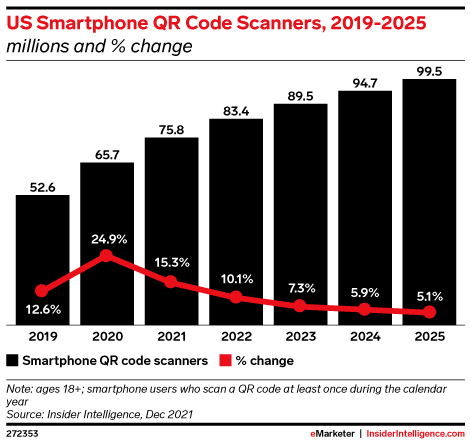
Graph from eMarketer showing the rise of QR code scanner usage.
For example,Happy Houruses free samples and QR codes at in-person events to encourage people to buy more products online.
“I went to a Lorde concert at the Shrine Auditorium in LA,” says Jonathan Roque, content marketing manager atSmile.io.“我有一个免费样品的快乐时光,爱它。It was also available at the bar. I bought Happy Hour at the concert, scanned the QR code, went home, and bought more online.”
2. Live ads + QR codes + TikTok videos
Marketers also use QR codes on live ads to drive traffic back to TikTok.
Michael Miraflor, chief brand officer at venture capital firmHannah Grey, saw Mulberry use this strategy and posted about it onTwitter.
Miraflor说桑发布一系列四poster ads with a branded QR code. The QR code redirects interested passersby to a zine, hosted on a TikTok landing page, that serves as a microsite brand experience.
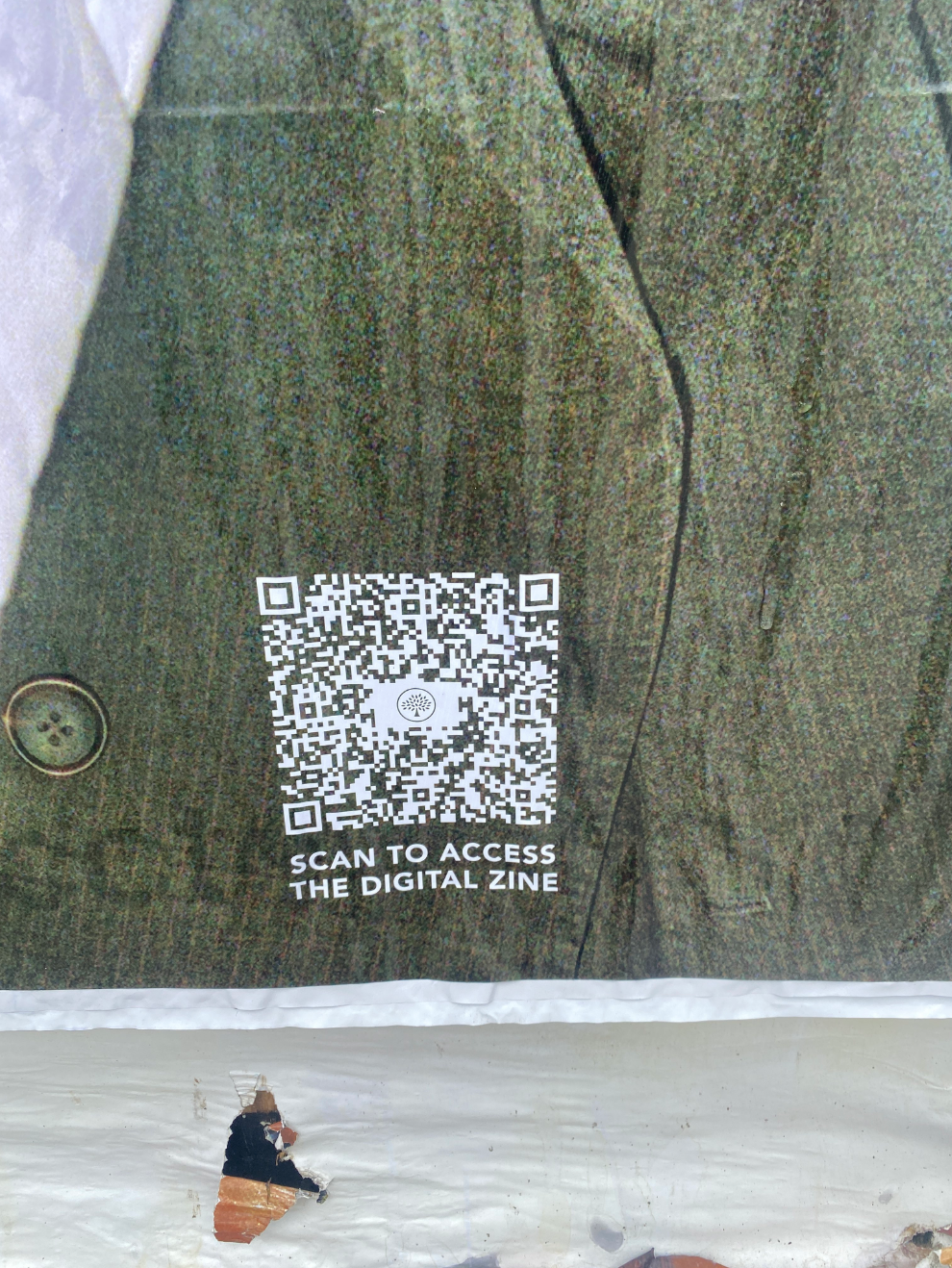
Example of QR code being used by Mulberry.
“I appreciated the Mulberry omnichannel campaign execution because the experience felt full-funnel, in that every bit of the consumer journey—from encountering the creative on the street to scanning the branded QR code to browsing through the zine content—felt very considered,” says Miraflor.
“The fact that OOH is one of the media channels driving toward a digital experience is great. It feels modern and omnichannel.”
This strategy is a stellar way to keep foot traffic engaged in content and other popular digital channels.
3. Social ads collecting customer data and sending customers in-store for free product
O2O (online-to-offline) commerceis also on the rise. O2O commerce is an omnichannel strategy where merchants work to bring online customers into physical stores to boost sales and loyalty.
Nikhil Venkatesa, content marketing lead atConvictional, provides a great example of how brands are using this technique.
He says brands likeStimulateare creating Instagram ads that collect a customer’s phone number and ask them to buy a product in-store. The customer will send the receipt as proof of purchase, and then the company will reimburse the expense on Venmo.
“Marketers get the double whammy of collecting a phone number for following up on SMS marketing, and you actually influence customers to try the product for free and see how awesome it is,” says Venkatesa.
4. Quizzes to collect data and personalize direct-mail content
Quizzes are an interactive tool marketers use to personalize products and marketing materials.
L’Amarueis one brand using this strategy. It uses an interactive quiz on its website to learn more about its customers’ individual skin care concerns.
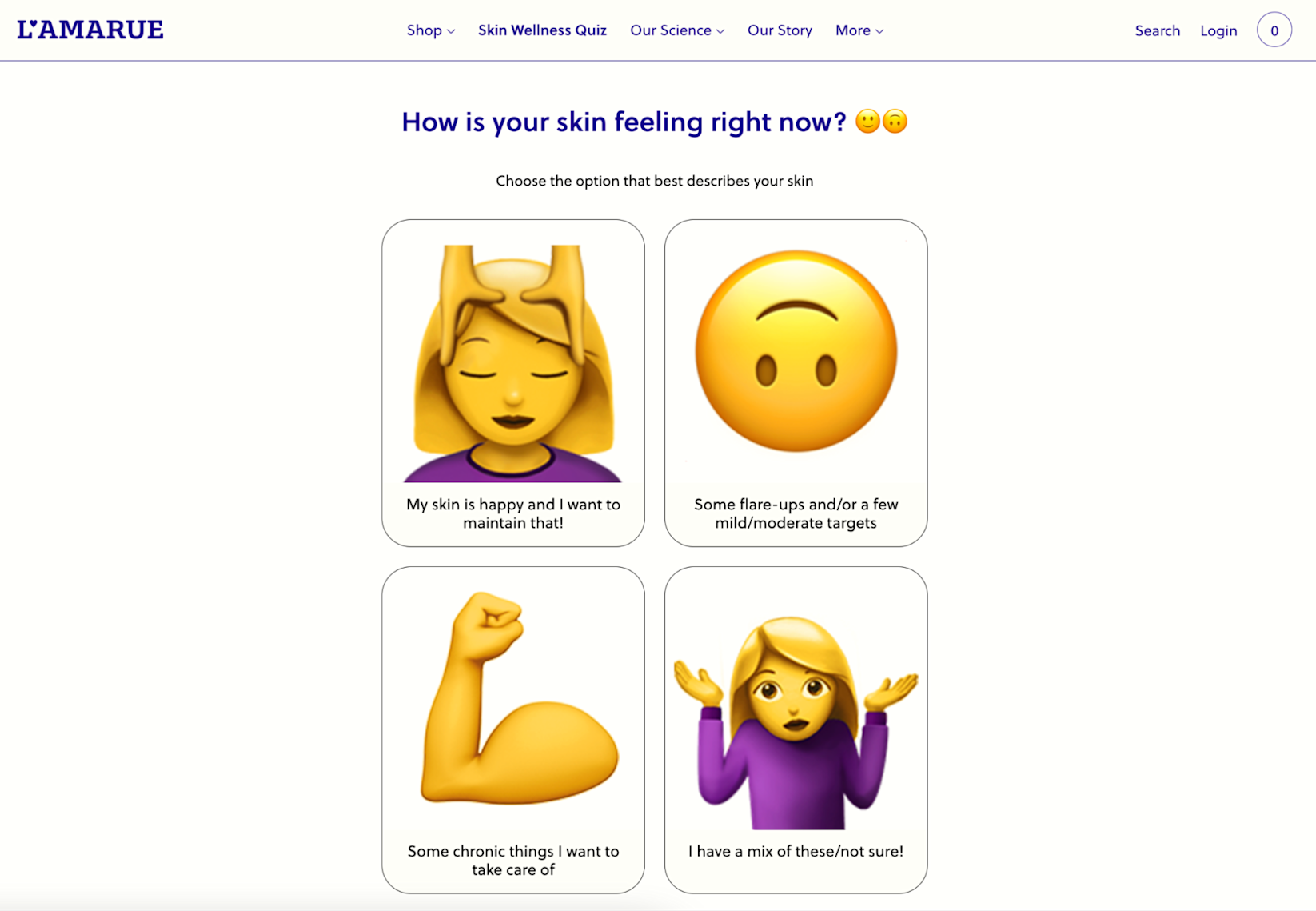
第二个问题在L 'Amarue瞿的皮肤健康iz on its website.
Then, L’Amarue takes this information and sends a complimentary physical pamphlet in the customer’s order. The pamphlet has tips on how to improve their specific skin care concerns.
“This strategy is a great way to bridge the digital and physical experiences of our brand, and a way to connect with our customer base in their everyday usage of our products,” says Ande Sozzi, CEO and founder of L’Amarue.
“Collecting data directly from every individual customer has been a game-changer in making every physical experience unique and meaningful for our customers. It’s like having a member of our team on the ground with them, giving them info, tips, and tricks, and someone to hold their hand through their specific journey.”
What’s interesting about this example is L’Amarue is a small skin care brand with a team of only two. Omnichannel marketing doesn’t require a huge budget or team—only a smart strategy.
5. Online brands expanding into new retail locations
Some brands likeAllbirds and Parachute Homes are opening their own storesto be closer to suburban shoppers. Others are collaborating with retailers to bring their products into physical stores, but not necessarily their own.Olipopis a good example.
Ed Kolovson, director of business insights at Olipop,tweetedabout how expanding into retail has boosted the brand’s sales: “Olipop has increased door count by about 50% since the start of the year (excluding Walmart launch). … Sales have not declined one bit and Amazon sales have increased over 50% since the start of the year.
“Expansion into retail has led to more awareness and customers are able to try the product in stores first. This has led us to an increase in first time purchasers subscribing thus increasing our lifetime value.”
How to create an omnichannel campaign
- Use customer data to create a personalized shopping experience
- 确保在platfor您的消息是一致的ms
- Connect with your customers during in-store shopping experiences
- Engage your customers across all high-touch channels
- Choose the right tech stack for omnichannel marketing
Use customer data to create a personalized shopping experience
The customer journey for physical goods used to be relatively straightforward. Consumers would make a shopping list, go to the store, pick up products, check out, and go home.
With advancements in commerce technology, an abundance of online and offline shopping options, and variations in consumer preferences, no two customer journeys look alike. Yet customers still demand highly personalized marketing messages and shopping experiences everywhere they shop.
The key to meeting consumer demands lies in capturing and leveraging data. “Omnichannel data is a valuable asset. When moving to a new channel, you can examine data generated by your existing visitors and customers to determine how to launch or expand,” says Bram Jansen, chief editor atvpnAlert.
确保在platfor您的消息是一致的ms
One of the benefits of omnichannel marketing is that it ensures your marketing isn’t disjointed across platforms—which can also pay dividends for your store in the long run.
Gavin Flood points to a study by Yes Lifecycle Marketing, which found that two-thirds of brands found it challenging to coordinate campaigns across various channels due to limited time and resources—a problem further complicated by the spread of new channels.
“By shifting your focus from channels to customer experiences, understanding your buyer persona, and segmenting your buyers, you will be able to deliver the right message to the right user through the right channels,” he says.
Connect with your customers during in-store shopping experiences
One of the more advanced tools of omnichannel marketing is mobile location data combined withfirst- and third-party audience data.
Geo-targeting technology can help target specific consumers during the “moment of truth,” like when they first stepped foot into your brick-and-mortar store.
But be sparing and strategic while using geofencing marketing or mobile GPS. You want to make sure the shopper has consented.
Often you can get that consent when offering store Wi-Fi or when a user downloads an app. Then, in the customer’s mind, it makes sense that you would provide offers or suggestions, because they’re an active participant.
Engage your customers across all high-touch channels
The goal of omnichannel marketing is to meet shoppers with highly personalized messages at every phase and channel of the customer journey.
This means it’s essential to understand your customers and reach shoppers wherever they are—be it a brick-and-mortar store, a live event, social media, in-app, or on your website.
This is no easy feat. “The omnichannel approach requires all hands on deck, not just those on your marketing team,” says Kai Ravariere, founder and principal atThe KR Agency.“Every team that generates or leverages customer and prospect data needs to adopt a system and process for harnessing that data in order for the brand to be able to personalize and add real value to every customer interaction in their universe.”
While it takes time and teamwork to develop a successful omnichannel strategy, it’s also essential to dive deep and understand where your specific customers live.
“Be strategic about the channels you choose,” says Ravariere. “Gaining a strong command of where else your customers spend their time, online and off, will prove immensely helpful in testing and identifying which additional channels your brand should be on to intercept their attention and strengthen customer relationships.”
Your research will lead you in the right direction, but consider integrating the following into your omnichannel marketing strategy:
- In-store experiences:Loyalty programs, digital kiosks, and buy-in-store-ship-it-to-your-home are all ways brands and retailers can engage consumers.
- Social commerce:Marketers can direct shoppers from photos on social media directly to product pages, and consumers can also buy directly onTikTok,Facebook, andInstagram.
- In-app:Mobile devices are a powerful shopping tool, and now it’s possible to create your own mobile app, market, and make sales right within yourShop app.
- Email marketing and SMS:Capturing email addresses and numbers across channels and during a potential online purchase helps brands and retailers nurture customers to purchase.
Choosing the right tech stack for omnichannel marketing
Data collection—including traffic, on-site interactions, personal data, purchases, and searches—is critical to powering ecommerce omnichannel personalization. The same goes for tracking your success with the right metrics.
“While marketers measure the overall effectiveness of the campaign, they don’t measure the KPIs at every stage of the buyer’s journey, preventing them from deriving meaningful insights,” says Flood.
But figuring out what data to use and how to track it is only going to get more complex, especially with Chrome phasing out third-party cookies. First-party data collection will become increasingly important for merchants, and AI solutions will lead the way to do some of the heavy lifting and help scale marketing automation.
Omnichannel marketing examples
Lounge Underwear
With a focus on consistent messaging, omnichannel personalization offers merchants the opportunity to both establish and reinforce their brand’s identity and values. That was the case for Shopify Plus merchantLounge Underwear, a UK-based home apparel merchant.

“A year ago, we had just begun establishing ourselves in the U.S. market,”writes Kiran Bains, head of paid media at Lounge Underwear.“It’s hard to break into the U.S. as a young British start-up, especially as an ecommerce brand. To be successful, we needed to keep our messaging cohesive in every element of our campaigns.
“From the moment someone finds us on social media, to when they sign up for an email and receive a targeted ad, we have to determine: how do we talk to someone cohesively throughout their customer journey?”
Lounge Underwear found its answer by engaging the services of marketing platform AdRoll. With AdRoll’s assistance, Lounge Underwear’s 2.3 million Instagram followers and 230,000 Facebook fans are now presented with high-quality photography, which allows them to click through to the brand’s store. There, they can access resources on style and fit, as well as incentives to purchase and the opportunity to opt into the company’s email list.
They’re then targeted across social channels, web pages, and devices. This is all a key element of creating a connected experience—and one that’s heavily focused on reinforcing the Lounge brand values. Contacts created through email collection are also leveraged with AdRoll data to identify similar audiences to grow the pool of future customers in driving engagement with the brand.
The result? Exponential revenue growth.Lounge Underwear increased revenuefrom social platforms by 388%, while managing to drop new audience acquisition costs by 78%.
Big Blanket Co.
Shopify Plus merchantBig Blanket Co.——销售“the biggest, best blankets in the world”—wanted a mobile-first marketing strategy that delivered customer support on every touchpoint. Delivering personalized and timely responses was also important to the brand.
The brand reached out to Attentive as part of an omnichannel marketing campaign. In addition to launching a campaign that triggered text messages to subscribers for personalized experiences, Big Blanket Co. also used historical customer purchase data stored in Shopify to create additional SMS segments, such as subscribers who have abandoned their carts, visited the website, or purchased a specific product or category.
The result? Within only four months of launching its SMS marketing program, text messages sent via Attentive accounted for 18% of Big Blanket Co.’s total revenue.
BUBS Naturals
BUBS Naturals sells fitness and nutrition products. It realized it needed to improve its marketing and boost its online sales, so, it turned to Shopify Plus.
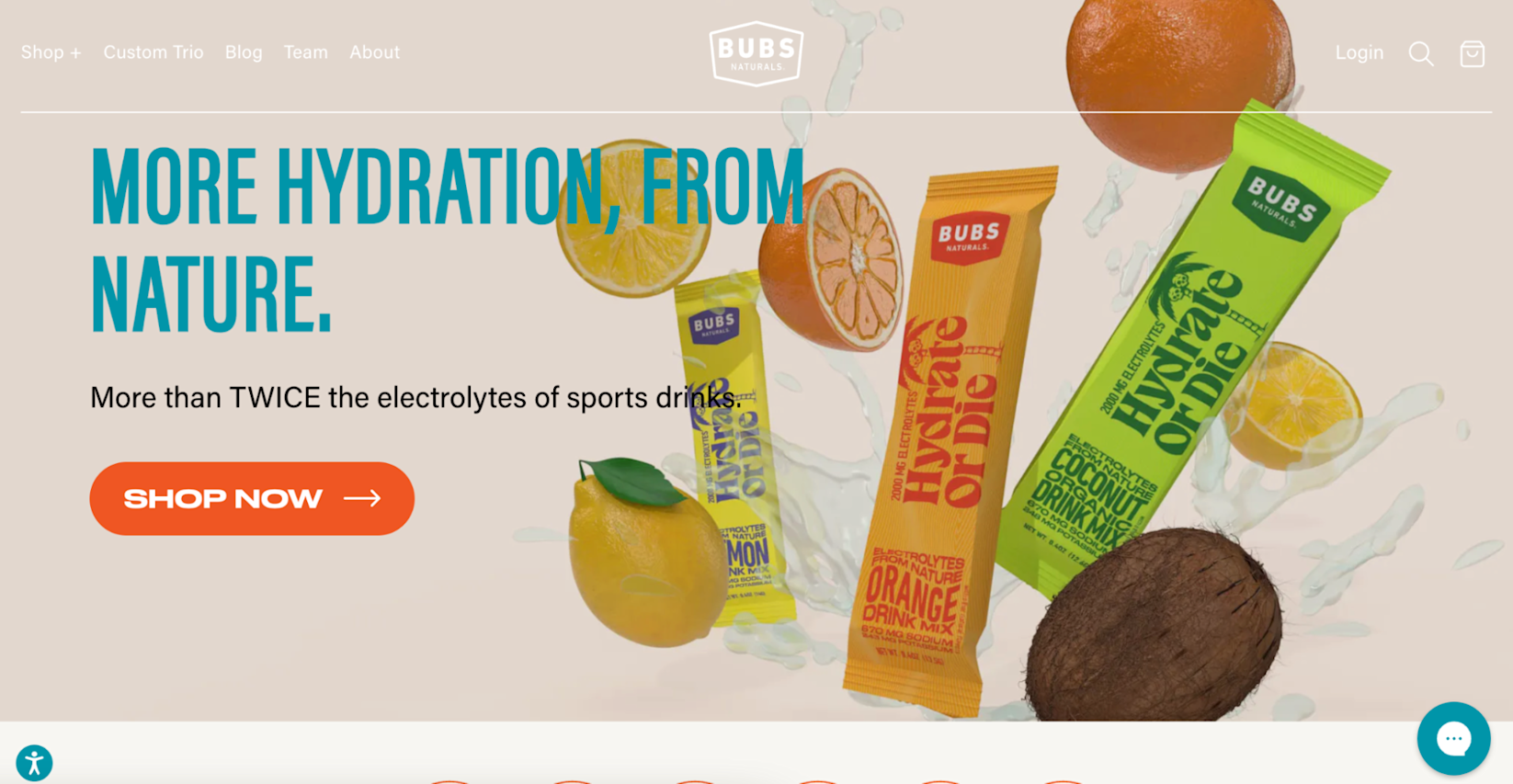
To help find more customers, BUBS Naturals started using a special feature on Shopify Plus called Shopify Audiences. This feature helped it identify groups of people who were more likely to be interested in its products. This made its advertising more effective and helped it reach more potential buyers.
TJ Ferrara, co-founder of BUBS Naturals, says using Shopify Plus allowed the brand to take control and make its online store much more profitable. OnceBUBS Naturals upgraded to Shopify Plus, it added new features to its online store. It set up different levels of discounts based on customer groups and made sure to turn off discount codes during big sales. With Shopify Plus, BUBS Naturals could handle all of these things on its own, without outside help.
This new approach was a big success for BUBS Naturals. Its online store conversion rate doubled. Its direct-to-consumer site’s revenue went up by 10%, and 84% of customers came back to shop again.
Sephora
Beauty mega-shop Sephora has long built loyalty with its shoppers by providing rewards for every purchase and offering a gift on members’ birthdays.
Take Sephora’s beauty workshops, in-store makeovers, and product testing, for example. Its online membership program replicates the personalized customer service you get as a regular customer—and it’s giving the brand a great ROI, considering that its10 million members tend to spend 15 times moreon its website than those without a nurtured relationship.
“According to theRetail Personalization Index 2022, Sephora is first on the list of brands that personalize,” saysAleksandra Korczynska ofGetResponse.“All their stores were closed during the pandemic, but the company immediately switched to VR demos and virtual consultations. I find this company very customer-centric; the moment you enter their website, they define your location to show you the nearest stores. Sephora’s chatbot offers personalized recommendations, so it is equal to the ladies in their physical store that help you choose the best products.”
BonLook
BonLooksells prescription eyeglasses and sunglasses in stores across Canada and worldwide online.
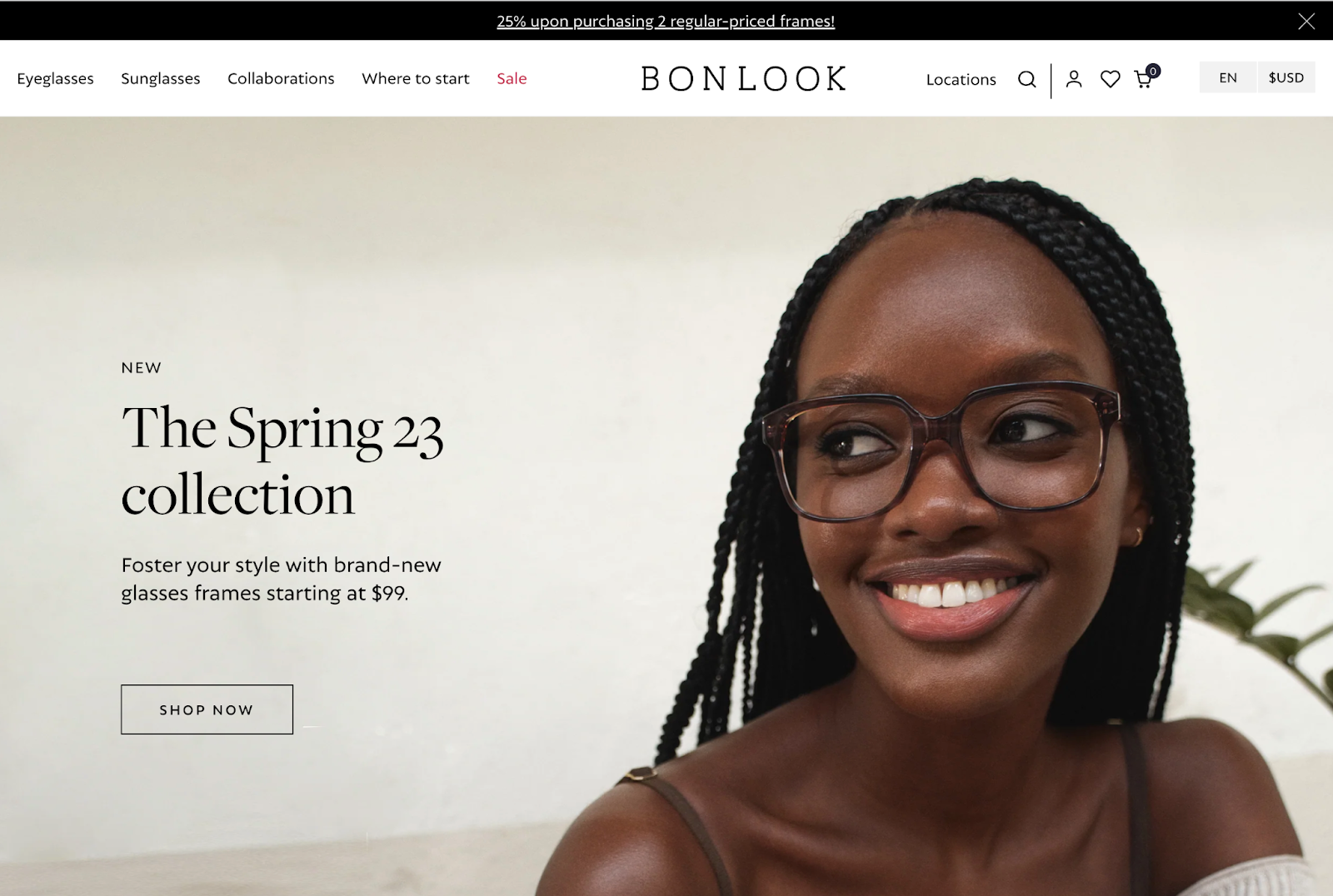
buyin买眼镜是个性化的,独一无二的g process, including lens materials, prescriptions, frame types and sizes, styles, and additional lens features. It naturally lends itself to brick-and-mortar shopping.
To replicate this in-store experience for online customers, BonLook launchedshopping guidesas well as a virtual try-on feature. It gives customers a 180-degree view of how glasses will fit them.

It also offersa custom iOS app that allows associates to help customers decide on frames and then make their purchase. The app integrates with the online store, so customers can purchase that way if they want. In-store associates can see inventory and orders in real time.
BonLookruns this integrated omnichannel strategy on Shopify Plus. Since switching from its previous solution, it has increased its average order value by 18%. As many as 15% of shoppers buy again within six months.
Rothy’s
Rothy’ssells comfortable everyday shoes and accessories made from recycled materials. Its omnichannel strategy focuses on unified customer support and a sustainable returns and exchange process.

First, Rothy’s wanted to bring all its customer conversations to a single platform. The goal was to avoid making customers repeat their issues to different agents, regardless of the channel.
All customer conversations were stored as individual tickets before the brand started usingGladly for customer support.If a customer email came in, agents didn’t see previous chat conversations or phone calls. Customer service was slow, and customers had to fill in the gaps each time.
With a single conversation timeline, agents now see the entire customer history. Customers can get help on any channel they want, without sacrificing the quality of the answer they’ll get.

A customer doesn’t even need to have their order number handy—Gladly pulls customers’ orders from Shopify into their profile on Gladly, for a true 360-degree customer view.
“We want to give them the channel of their choice,” Nic Cadwallader, director of customer experience at Rothy’s,told CGT.“We also wanted to leverage our website. We wanted to make sure that we were putting information that’s usable … that we could embed chat capabilities, where they can talk to somebody, but also that we can direct it and predict what questions they might have.”
Second, when Rothy’s opened its first brick-and-mortar store in 2018, it realized it needed to improve its returns process. In-store returns weren’t sustainable, as they createdlong lines around the block.
The brand’s customers value sustainability, and returns by mail in cardboard boxes weren’t ideal. Rothy’s implemented a returns bar solution and took advantage of an existing returns infrastructure. This encouraged in-person returns without a strain on the physical store.
It gave customers the option to shop and return the way they want, on a channel they want, and that aligned with their values.
Sweetwater
Sweetwatersells musical instruments and pro audio equipment in itsFort Wayne store, as well as online. It served millions of customers in 2022, crossing$1.57 billion in revenue.

Its retail location features massive guitar galleries, a drum room, and fully loaded demo studios. Sweetwater’s expert staff is there to help—a dream come true for a music gear buyer.
So what about shopping online? Sweetwater’s omnichannel strategy helps recreate the in-store experience.
Sweetwater’s category pages feature buying guides for the category you’re viewing at the top:

As you browse categories and products, the top bar and the bottom right corner remind you to ask for help through phone or email, if you need it:

The real magic happens as you get deeper into your buying journey. Sweetwater embodies the seamless omnichannel approach to customer experience and assigns each customer a sales engineer.
These sales engineers learn about the customer’s style, setup, and ambitions, and help them choose the best option. Even before they make a purchase, shoppers can quote their cart ID so agents can instantly see what they’re shopping for:

“It’s never about a sale, it’s about providing the best experience possible during every interaction,” Chuck Surack, Sweetwater’s CEO and founder,told Retail Customer Experience.“我们的销售工程师花13周的训练before they’re able to interact with customers. … That commitment to making sure our employees have the tools they need is uncommon within the music retail industry,”
He calls the brand experience omnichannel, while remaining “dedicated to investing in an ‘old-school’ approach to customer experience.”
After buying from Sweetwater, customers get an email follow-up, a phone call from a sales engineer to answer any questions about the order, and another call after the items arrive.
Music gear often includes highly personal and big-ticket items. Sweetwater knows this and creates an experience that matches it, even when it’s not in-store.
ILIA Beauty
ILIA Beautyis a clean beauty brand sold online and in stores like Sephora, Credo, and Walmart.

Its online shopping experience takes into account the fact you can’t try out a lipstick color in real life. That’s what the “Find My Shade” option is for:

Choosing a foundation shade is no different. There’s an extra option here: uploading a selfie to get help from a brand specialist.

Wherever customers shop from, they can go through express checkout withShop Payor PayPal.
ILIA’s omnichannel efforts also include offline advertising. It includes a feature on a Manhattan tour bus, billboards in LA, and wild postings in New York City. These were placed near Credo and Sephora stores.
Cocomelody
Cocomelodysells affordable wedding dresses, bridesmaid dresses, and formal dresses.

Its digital marketing team used Google Ads and sponsored Facebook posts to drive customer engagement. Butit struggledto keep these users around, and its ad conversion rates were stagnant.
一旦看了看数据更全面,它aw a high cart abandonment rate, but also that these users came back to the site often. Cocomelody’s customers were interested, but struggling: they couldn’t touch or try on these dresses.
The solution:home try onfor just $25 per dress, plus easy returns, andfabric swatchdelivery.
Cocomelody then targeted cart abandoners to let them know of these new options, including push notifications, SMS messages, and personalized emails. This increased sales by 30%.
Other assets Cocomelody built to provide a seamless customer experience includecolor charts, aFacebook groupwith more than 36,000 members,fit guides, and measurement guides.
Want more omnichannel marketing examples? Read our posts on examples of omnichannel brands andwhat you can learn from them.
How Shopify can help with omnichannel marketing
In today’s highly competitive retail landscape, omnichannel marketing is essential to the success of your brand. It’s also not an easy endeavor, and takes time, tools, and strategy to get right.
Thankfully, Shopify Plus has its point-of-sale and ecommerce systems integrated into one easy-to-use platform. Shopify Plus helps merchants create personalized experiences for customers—no matter where they are engaging with your brand.
Omnichannel marketing FAQ
What is an omnichannel approach?
An omnichannel approach is a multichannel sales strategy that seeks to provide customers with a seamless shopping experience, regardless of the sales channel used. It involves integrating all of a company’s online and offline channels into a single, unified customer experience. This could include things like providing customers with the same product selection, pricing, and promotions across all channels, as well as offering customers the ability to purchase items online and pick them up in-store. If you’re a Shopify merchant, you can sell anywhere (including brick-and-mortar, using our POS) while maintaining a unified view of your business in one platform.
Is omnichannel a marketing strategy?
Yes, omnichannel is a marketing strategy that seeks to provide customers with a seamless shopping experience across multiple channels, such as brick-and-mortar stores, websites, mobile apps, social media, etc. The goal of an omnichannel strategy is to create a consistent brand experience, no matter where a customer interacts with the company.
What is omnichannel marketing vs. multichannel marketing?
Omnichannel marketing is a strategy that integrates multiple channels, such as digital, physical, and social media, to provide a seamless, unified customer experience. The goal is to give customers a consistent experience across all their interactions with a brand.
Multichannel marketing utilizes single channels such as television, radio, print, digital, and social media to reach customers with different messages. While multichannel marketing does provide opportunities for brands to reach a larger audience, it may not always provide a unified experience across all channels.
What is an example of omnichannel?
An example of omnichannel is a retail store that offers customers the ability to shop online, in-store, or through their mobile app. Customers can view products on their website or mobile app, purchase items in-store, and receive customer service through phone, email, or live chat. Additionally, customers can receive special offers and rewards across multiple channels.






